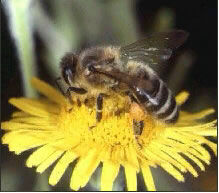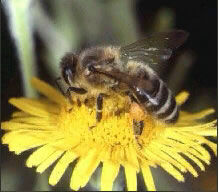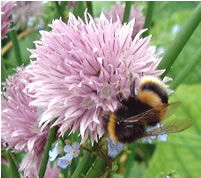Honey Bees, Bumble Bees, Solitary Bees and Wasps

Introduction
From February the very large furry bees appear, you might notice the various colours and be amazed or you might well be alarmed by such animals which for a few people are scary. This is probably a reaction to a childhood encounter, threats by a cajoling mother, actually being stung or bitten by insects. Such phobias exist, often for the wrong reason, researching and finding out facts about the lifestyle and ecological importance of the insect that scares you will likely overcome your fear and indeed encourage you to see these insects in a different light.
I am plagued by telephone enquiries every Summer from well intentioned people asking the same or similar questions. Many questions can be answered by reference to a book, many can not, the following FAQ’s are to assist you to understand, then make the appropriate enquiry to a beekeeper or entomologist without wasting yours or their time on lengthy explanations. I make reference to wasps as well.
Bees and Wasps are divided into three recognisable types;
1. Honeybees

Honey Bee Castes
A permanent highly organised and communicating social insect having a fertile egg laying queen, between 10k & 90k infertile but highly skilled & organised female workers and some rather lazy males called drones per colony. A great deal of information is readily available from the Internet, libraries, bee research Institutes and Universities in the UK and world wide with an International library in Wales http://www.ibrabee.org.uk/

Honey Bee Foraging on a Flower
2. Bumble bees
Firstly there are some three or four books published in the UK and the Bumblebee Conservation Trust has useful public information that can help identify the various species.
Bumble bee queens, (Bombus sp) live just about twelve months, they emerge as virgin queens from nests underground and above ground between the end of July to the middle of August, it may now be earlier due to climate change, they build up body fat ready for five months of hibernation, the queens vary a little in size dependant on breed and the quantity of larval food consumed. The largest are equivalent to the size of your thumb from it’s tip to the first joint, colours vary from all black, black with white or orange abdominal tip to brilliant rusty or yellow bands and multi coloured dull rusty to primrose yellow bands. Finding good illustrated coloured plates is, I must say difficult, so why not take a photograph of some bumble bees and submit them to the webmaster!
The queens emerge in Spring from hibernation, they first search out nectar bearing flowers from which they feed on nectar and pollen at the same time pollinating those flowers causing seed to be set. When nice and plump and feeling the time is right they search out a suitable nest site, a disused mouse nest underground, thick grass tufts over ground and warm roofs above ground, commonly they are to be found in compost heaps which provide moist warm environment suitable to their needs.
The queen builds a saucepan like cell of wax and lays several eggs in it, she feeds and cares for the larvae. As these worker bees emerge they take over nursing and feeding, foraging for pollen and nectar amongst the flowers in your garden.
Bumble bees are no threat whatsoever, if you have young children then they are an ideal social insect to watch and learn about. Peg out four sticks around the nest area to indicate the nest position, say two foot by two foot or for the children 60cm by 60cm, now look through your natural history books with the children to identify which specie you have. Take the children to the library to search through more books if yours do not have sufficient information. See what colour pollen the bees carry on their legs, ask the children if they can see the same colour pollen on the flowers in your garden. Use a clock or stop watch so the children can count how many bees leave the nest in a minute, how many return in a minute repeat this three times during the day, aggregate the sums and divide up to find the average. Bumble bees leave the nest for thirty to sixty minutes; see if you can calculate how many bees might be in the nest. Bumble bees never swarm like honeybees and rarely reach more than seventy bees in a colony, that said I found three nests in 2001 with over 500 bees and four pounds of honey.

Bumble Bee collecting pollen and nectar
If you need to remove the bumble bees from your house, compost heap or garden for some compelling reason and remember they die out in August / September, providing it can be accessed it is a simple matter to collect up the nest by a honeybee keeper. The nest must be carefully exposed all round until it is above it’s surroundings, a small shovel, spade or adequately thin strong tool is needed to slide below the nest lifting it as a whole, a cardboard box laid on it’s side with flaps open ready to receive the nest, slide the nest carefully into the box, stand the box where the nest was until dark when it can be closed up with all the bees inside, tape the box shut, punch small ventilation holes through the box. Take the box over two miles away and lodge in a sheltered place under a shed or some sort of protective cover. Bumble bees are endangered, it is illegal to kill the bees, anyone found to have poisoned them risks prosecution, the maximum fine in the Magistrates Court is £25k, unlimited in Crown Court, average fine imposed at present is £1,5k. You can purchase a proper bumble bee home for £25. Bee keepers will charge to remove these nests when absolutely necessary, average cost £45.
3. Solitary bees
There are over two hundred different types in the UK most do not sting, any that could do not because their stings are too weak to penetrate us. If your garden, house or outbuildings present the right accommodation requirements then you may be blessed with solitary bees, which come in all sizes and shapes and colours. The adult bees are visible only for 6-8 weeks during their breeding cycle which coincides with the flowering period of those flowers that produce pollen and nectar suitable for their particular needs. This flowering period often coincides with the honeybee swarming period thus causing confusion as to what bees they are. Although no danger exists it is a fact that some people are terrified because they do not understand the bees. To remove solitary bees to a different location is impossible and it is illegal to poison them just as with bumble bees. There is a method to relocate them if done at the right time, that is to deny them access to the nest site they emerged from with the use of a screen, use one of the artificial nest blocks that you can purchase or make, site this in front of the screen. When the bees have disappeared after a few weeks remove the nest block to a new location in the garden in a sunny South facing area. You may have to erect the screen in successive years as well as providing artificial nest sites. It would be easier to learn exactly which specie of bee you have, study its lifestyle in depth then ignore the problem you currently perceive.

